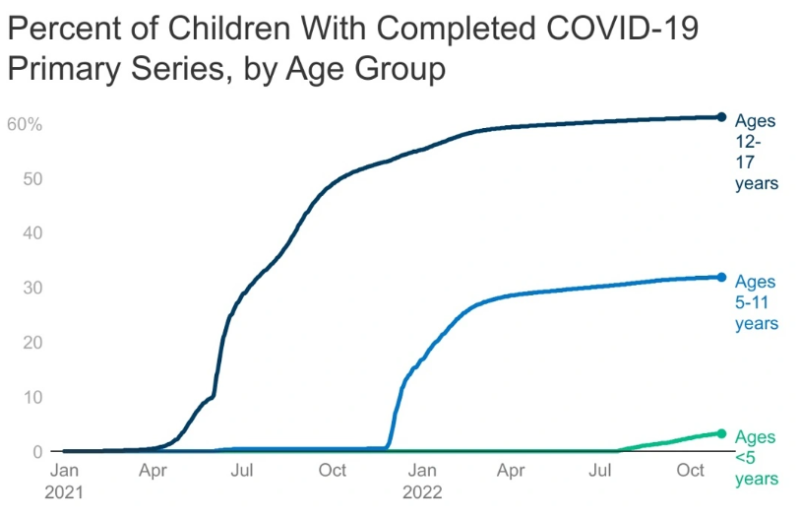Almost as soon as it became apparent that COVID-19 symptoms can linger for more than four weeks, experts began investigating long COVID’s effects on adults. Because children and adolescents display greater resistance to infection from SARS-CoV-2, long COVID’s effect on that demographic hasn’t been studied as much, at least until now.
PLOS Medicine last week published a matched cohort study of 157,134 individuals who’d been infected with COVID-19. Researchers with the Technical University of Dresden in Germany found that children (aged 0 to 11) and adolescents (aged 12 to 17) are at equal risk of having long COVID-19 symptoms 90 days after severe infection as adults. The study group comprised 11,950 children and 145,184 adults matched to a control group of identical age, sex and preexisting conditions but who had not contracted COVID-19.
COVID-19 caused a higher long-term demand for healthcare services at both inpatient and outpatient settings for a broad spectrum of symptoms. Though children and adolescents were less affected, the authors did conclude that incidence of long COVID among youngsters proved to be statistically significant and therefore cannot be dismissed. In addition, children and adolescents suffer from more mental health problems because of long COVID than adults do, the study found.
“In children and adolescents, the [incident rate ratio—IRR] of documented new-onset mental health problems during follow-up was higher compared with adults, whereas the opposite was true for documented health outcomes of the pulmonary diagnosis/symptom complex,” the study states.
At present, there exist no generally agreed upon best practice guidelines for diagnosing and treating long COVID, but that doesn’t mean that employers haven’t thought about it. Elizabeth Mitchell, president and CEO of the Purchaser Business Group on Health, told Fierce Healthcare recently that “our members are absolutely looking at the data [about long COVID] and there is recognition—even though it’s not quantified yet—that there is going to be an impact on cost, but also on employee health and well-being. I think there’s a big unknown about what the impact is going to be, but there is at least acknowledgement that there will be an impact and that employers are going to have to adjust.”
Because long COVID affects children, just how long payers and employers will need to deal with the problem represents another big unknown.
In the PLOS Medicine study, results were derived from healthcare data researchers gathered in a review of medical records between Jan. 1, 2019, and Dec. 31, 2020. Researchers began to analyze the information in May 2021. Data were grouped into three categories: physical health, mental health and physical/mental overlap.
The IRRs for adults were highest for loss or hampering of taste and smell, fever and respiratory problems such as dyspnea, cough and respiratory insufficiency. Then came throat and chest pain, hair loss, malaise/fatigue/exhaustion, dysphagia and headache.
For youngsters, IRRs were highest for malaise, fatigue/exhaustion, cough, throat/chest pain and adjustment disorder. Then came somatization disorder, headache, fever, anxiety disorder, abdominal pain and depression. Children who’d gotten COVID-19 were 30% more likely to exhibit long COVID symptoms than those who hadn’t. And some symptoms plagued both children and adults: cough, fever, headache, malaise/fatigue/exhaustion, throat or chest pain.
Daniel Blatt, M.D., is a pediatric infectious disease physician at the post-COVID clinic at Norton Children’s Hospital in Louisville, Kentucky, and was not involved with the study. He tells CIDRAP, a publication of the University of Minnesota, that “it’s unclear if long COVID is the same in children and adults, in terms of pathophysiology, but it’s just as real.” He says that although children “tend to get better, regardless of what intervention is needed,” when it comes to long COVID, providers need to know that the problem, whether mental or physical, is real.
The effects of long COVID on children and adolescents was also the focus of a study presented at the Society for Neuroscience annual meeting in San Diego. Researchers with the Children’s Hospital of Mexico noted that “although there are plenty of reports about adulthood sequels (Asadi-Pooya A. A., 2022), there is little knowledge about sequels in children.” They used functional magnetic resonance imaging to examine the sensorimotor regions of the brain in 240 children aged 10 to 13 years old infected with COVID-19 in the previous four to 15 months.
Researchers found that the children exhibited difficulty with sensory processing and executing complex movements. “These results indicate that post COVID-19 children may be presenting higher demands of resources when these regions perform this anticorrelation pattern compared to controls,” the study states.
